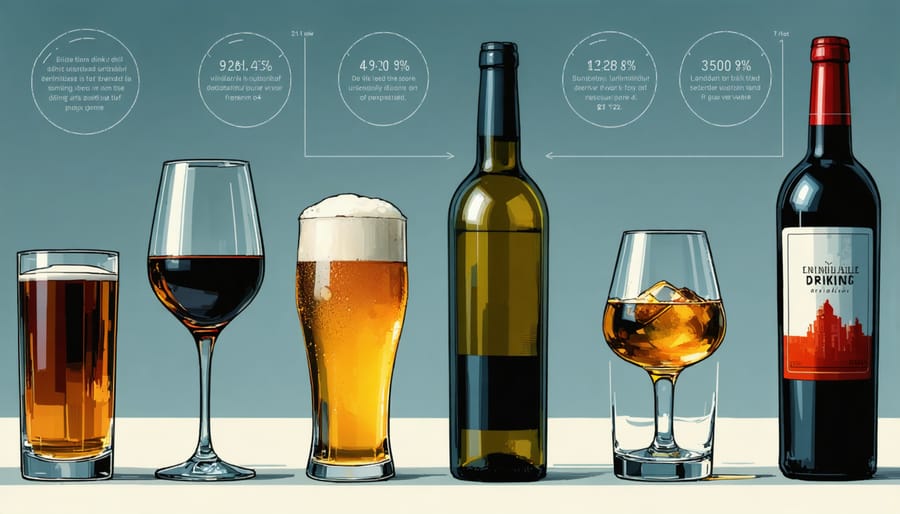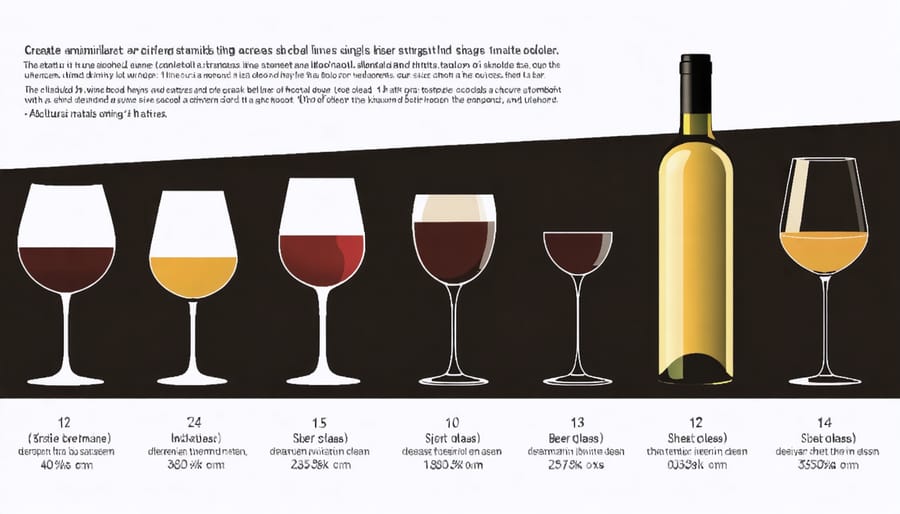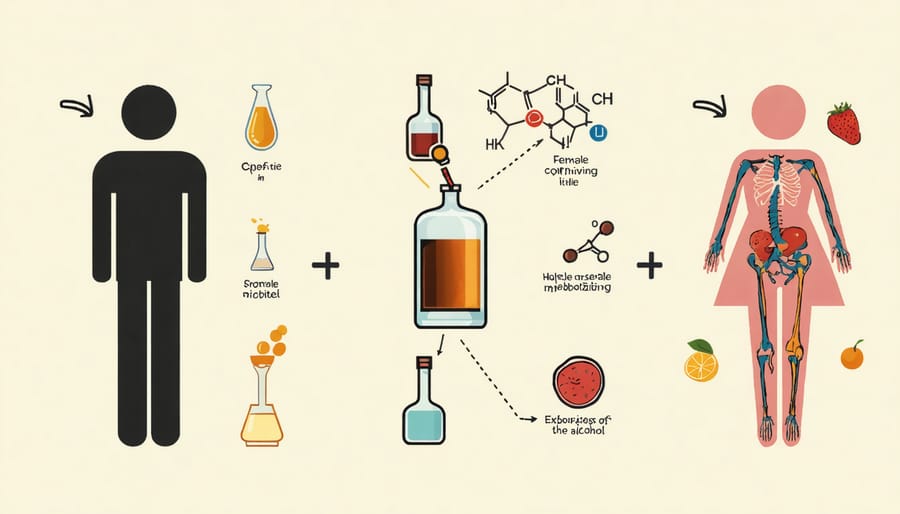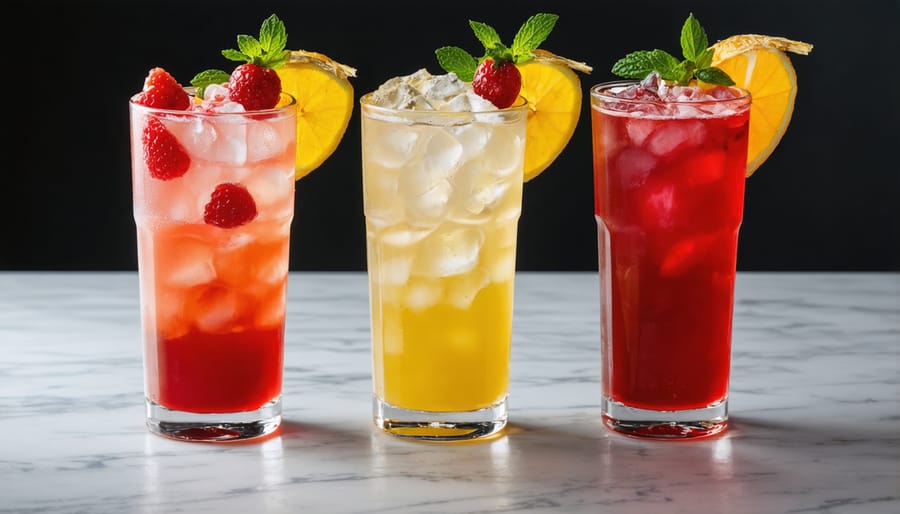
Let’s talk about what a “safe drink” really means in 2024 – because between weekend brunches, after-work happy hours, and that occasional glass of wine while cooking dinner, many of us are navigating our relationship with alcohol. Current health guidelines recommend no more than one drink per day for women and two for men, but here’s what you really need to know: a standard drink isn’t what most of us pour at home. That generous glass of cabernet might actually count as two or even three standard servings.
Recent research from the World Health Organization suggests that when it comes to alcohol consumption, less is always better for your health. While previous studies once touted potential benefits of moderate drinking, particularly red wine, current science paints a clearer picture: any amount of alcohol carries some risk. However, this doesn’t mean you need to swear off your favorite cocktail entirely.
Understanding your personal limits and making informed choices about alcohol consumption isn’t just about following guidelines – it’s about creating sustainable habits that align with your lifestyle and health goals. Whether you’re looking to cut back, maintain current habits, or simply become more mindful about your drinking, knowing the recommended limits is your first step toward making empowered decisions.
Understanding Daily Alcohol Guidelines
What Counts as One Drink?
Have you ever wondered if your “one glass” is actually counting as multiple drinks? Let me break it down for you in a way that’ll make your next happy hour much clearer!
A standard drink in the US contains 14 grams of pure alcohol, but what this looks like in your glass varies depending on what you’re sipping. For wine lovers, a standard drink is 5 ounces – think of it as a generous splash that fills about half of a typical wine glass. If you’re more of a beer enthusiast, one 12-ounce regular beer (about the size of a standard can) counts as one drink.
For those who prefer spirits, a standard drink is 1.5 ounces of distilled spirits (40% alcohol) – that’s about one shot glass. Here’s where it gets tricky: that gorgeous oversized wine glass at your favorite restaurant or that craft beer with a higher alcohol content? They might actually count as more than one standard drink!
Remember, ladies, when tracking your drinks, it’s not just about counting glasses – it’s about understanding what’s actually in them. Trust me, this knowledge is a total game-changer for mindful drinking!

Gender Differences in Alcohol Processing
Ever wondered why your partner can seemingly handle more drinks than you? It’s not just about size or tolerance – our bodies process alcohol differently based on gender. As women, we generally have less water in our bodies and more fatty tissue, which means alcohol becomes more concentrated in our system.
Here’s what makes the difference: we naturally have lower levels of an enzyme called alcohol dehydrogenase, which breaks down alcohol in the stomach. This biological factor means that even if you drink the same amount as a male friend, you’ll likely experience stronger effects. To better understand how alcohol affects you, consider that women typically reach higher blood alcohol levels faster than men, even when consuming identical amounts.
This isn’t about limitations – it’s about knowing your body and making informed choices. Many of us have experienced that moment when we realize our usual glass of wine hits differently after a busy day or on an empty stomach. That’s perfectly normal, and understanding these differences helps us make smarter decisions about our alcohol consumption.

Finding Your Personal Sweet Spot
Body Weight and Metabolism
Ever noticed how that glass of wine hits differently on an empty stomach? Your body weight and metabolism play crucial roles in how you process alcohol. Think of your body as a unique filtering system – the more you weigh, the more water content you have to dilute alcohol in your bloodstream.
I learned this firsthand when my friend Sarah, who’s petite, and I had the same drink at dinner. While I felt fine, she experienced the effects much more intensely. This isn’t just about size – your metabolism, influenced by factors like age, genetics, and muscle mass, determines how quickly your body breaks down alcohol.
For every drink you consume, your liver needs about an hour to process it. However, this timeline can vary significantly based on your individual characteristics. If you’re athletic with more muscle mass, you might metabolize alcohol more efficiently than someone with a higher percentage of body fat.
Remember, ladies, hormonal changes can also affect how we process alcohol throughout our menstrual cycle. This is why sometimes you might feel the effects of alcohol more strongly than usual, even if you’re sticking to your usual amount.
Lifestyle Considerations
When it comes to alcohol consumption, your daily routine and commitments should play a crucial role in your drinking decisions. If you’re heading to an early morning meeting or have a packed schedule with the kids the next day, it might be wise to skip that evening glass of wine. Similarly, if you’re training for a race or focusing on fitness goals, you’ll want to consider how alcohol might impact your performance and recovery.
Think about your social calendar too. Having multiple events in a week? Consider choosing some occasions to be the designated driver or opting for mocktails. This not only helps you stay within healthy limits but also maintains your energy levels for all your commitments.
Meal timing is another important factor. Drinking on an empty stomach can intensify alcohol’s effects, so plan your drinks around your meals. If you know you’ll be enjoying wine with dinner, perhaps skip the workplace happy hour that day.
Remember, there’s no shame in saying “no” to a drink. Many women are embracing mindful drinking, choosing when and where to indulge based on their lifestyle priorities rather than social pressure. Listen to your body and schedule – they’re usually the best guides for making these decisions.
Mindful Drinking Strategies
Elegant Alternatives to Heavy Drinking
Who says social gatherings need to revolve around heavy drinking? There are countless sophisticated ways to enjoy yourself while keeping alcohol consumption moderate or minimal. I’ve discovered that exploring alcohol-free alternatives can be just as exciting as traditional cocktails.
Try ordering a sparkling water with fresh citrus and herbs – it looks elegant and feels special without the alcohol content. I love creating “mocktail moments” by mixing premium tonic water with botanical-infused syrups and fresh garnishes. These drinks are conversation starters and often more interesting than standard cocktails!
Consider hosting themed gatherings that shift focus away from drinking: cheese-tasting parties, DIY tea ceremonies, or craft coffee experiences. These alternatives aren’t just healthier – they’re more memorable and inclusive.
When you do choose to drink, try the “spacer” technique: alternate alcoholic beverages with water or creative non-alcoholic options. This naturally slows consumption while keeping you hydrated and engaged in the social experience.
Remember, confidence is the ultimate sophistication. Ordering a creative non-alcoholic drink or nursing a single glass of wine throughout an evening can be just as chic as ordering multiple cocktails – and you’ll feel fantastic the next morning!

Tracking Your Intake with Style
Gone are the days of mental math and guesswork when it comes to tracking your drinks! I discovered some fantastic modern solutions that make monitoring alcohol intake both easy and stylish. My personal favorite is the Drink Control app, which lets me log drinks with a simple tap while offering a sleek interface that doesn’t scream “I’m counting my drinks!” to everyone at happy hour.
Several other apps like DrinkAware and AlcoDroid have transformed how we track our consumption, offering features like drink calculators, spending trackers, and even personalized insights based on your patterns. What I love most is how these apps send gentle reminders when you’re approaching your daily limit – like having a thoughtful friend looking out for you!
For those who prefer a more analog approach, there are some gorgeous wellness journals specifically designed for tracking alcohol intake alongside other healthy habits. I’ve seen some of my friends using stylish bullet journal layouts to monitor their drinking patterns while making it look like an art project.
Smart devices are joining the game too. Some smartwatches now include alcohol tracking features alongside their fitness metrics, making it easier than ever to keep tabs on your intake while maintaining your lifestyle goals. The best part? Most of these tools can be as discrete or as social as you want them to be, letting you take charge of your choices without compromising your social life.
When it comes to alcohol consumption, there’s no one-size-fits-all approach, but understanding and respecting your personal limits is key to maintaining a healthy relationship with drinking. As we’ve explored throughout this article, while moderate alcohol consumption can be part of a balanced lifestyle, it’s essential to approach it mindfully and with awareness of your individual circumstances.
I remember when I first started hosting dinner parties, I felt pressure to keep everyone’s glasses filled constantly. Over time, I learned that being a good host meant creating an environment where guests felt comfortable making their own choices about drinking, including choosing not to drink at all.
Listen to your body and be honest with yourself about how alcohol affects you personally. Some people might feel fine with an occasional glass of wine, while others might choose to abstain completely. Both choices are equally valid and deserve respect.
Remember that guidelines are just that – guidelines. Your personal alcohol intake should take into account factors like your health history, medications, lifestyle, and responsibilities. If you’re ever unsure about your drinking habits, don’t hesitate to discuss them with your healthcare provider.
Consider keeping a drinking diary for a few weeks to understand your patterns better. This simple practice helped me become more mindful of my own choices and led to more balanced decisions about when and how much to drink.
Above all, prioritize your wellbeing and make choices that align with your personal health goals. Whether you choose to drink occasionally, regularly within recommended limits, or not at all, the most important thing is making informed decisions that support your overall wellness and lifestyle.



